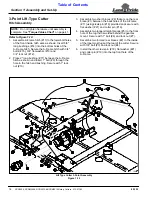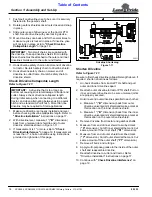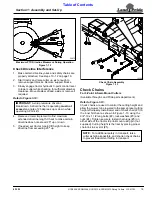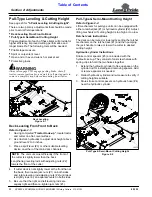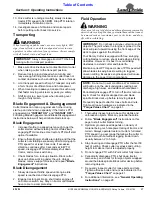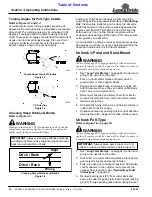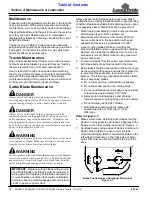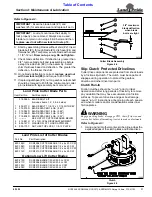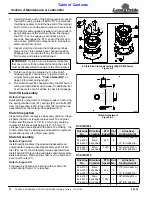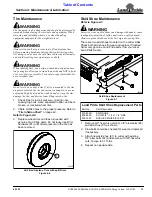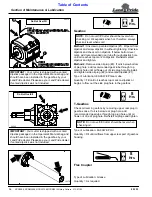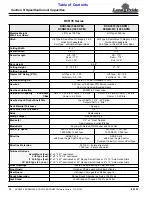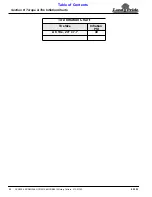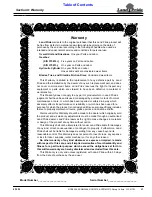
28
Section 3: Operating Instructions
RCR3596, RCRM3596, RCR3510 & RCRM3510 Rotary Cutters 312-517M
8/15/12
Table of Contents
Turning Angles for Pull-Type Cutters
Refer to Figure 3-1 and 2-3:
Avoid tractor-to-cutter turning angles exceeding 35
degrees if the main driveline is a standard conventional
drive shaft. The turning angle may be increased to 80
degrees if equipped with a constant velocity driveline
shaft. These extreme angles are intended for intermittent
usage only and not prolonged usage. Plan your field
cutting to minimize the number of turns as well as
extreme angles where turns are necessary.
Conventional U-Joint Driveline
Figure 3-1
CV Driveline
Figure 3-2
Crossing Steep Ditches & Banks
Refer to Figure 3-3:
!
WARNING
Damage to the tractor’s PTO components and/or driveline
components can cause driveline to come loose and cause
bodily injury to the operator and others.
Crossing Steep Ditches and Banks
Figure 3-3
11934
20795
IMPORTANT: Always cross steep ditches and banks
at a diagonal. Never cross straight across and never
back into a steep ditch or bank.
Ditch / Bank
Wrong
Right
Ditch / Bank
Cutting over ditches and backing up hills can tilt the
cutter’s back side up excessively resulting in “Bottoming
Out” the driveline. Bottoming out is when the driveline
shaft has shorten to the point it is pressing against the
gearbox and tractor PTO shafts. Once a driveline has
bottomed out, it can not be shorten anymore without
causing serious damage to the tractor PTO components,
cutter gearbox and driveline.
Do not operate a pull-type cutter at an angle exceeding
25 degrees up or down or at any angle that will force the
driveline to bind and/or hit the tractor drawbar.
Unhook 3-Point and Semi-Mount
!
WARNING
Always disengage PTO, engage parking brake, shut tractor
engine off, remove switch key, and wait for blades to come to
a complete stop before dismounting tractor.
1.
See “Long Term Storage” on page 34 if cutter is not
going to be used for a long time.
2.
Park on a level solid surface and lower deck to
ground level or onto support blocks.
3.
Engage tractor park brake, shut tractor engine off,
and remove switch key. Stay on tractor until blades
have come to a complete stop.
4.
Disconnect driveline and safety chain from tractor.
5.
Unhook 3-Point hitch from tractor and drive tractor
forward several feet.
6.
Reinstall hitch pins, linch pins, and hair pin cotters in
cutter hitch for safe keeping.
7.
Collapse driveline by pushing tractor end of driveline
towards the cutter. Support driveline off the ground.
Unhook Pull-Type
Refer to Figure 1-8 on page 14:
!
WARNING
Always disengage PTO, engage parking brake, shut tractor
engine off, remove switch key, and wait for blades to come to
a complete stop before dismounting tractor.
1.
See “Long Term Storage” on page 34 if cutter is not
going to be used for a long time.
2.
Park cutter on a level solid hard surface. Place tractor
gear selector in park and set park brake.
3.
Fully raise deck up to transport position. Add stroke
control spacers to the cylinder rod to prevent the
cylinder from retracting. See “Hydraulic cylinder
Instructions” on page 22.
4.
Remove parking jack (#1) from cutter deck and
secure to cutter tongue by fully inserting jack locking
pin (#2) through parking jack and mounting bracket.
IMPORTANT: Always place parking jack on a firm
surface or place a board under the parking jack for



